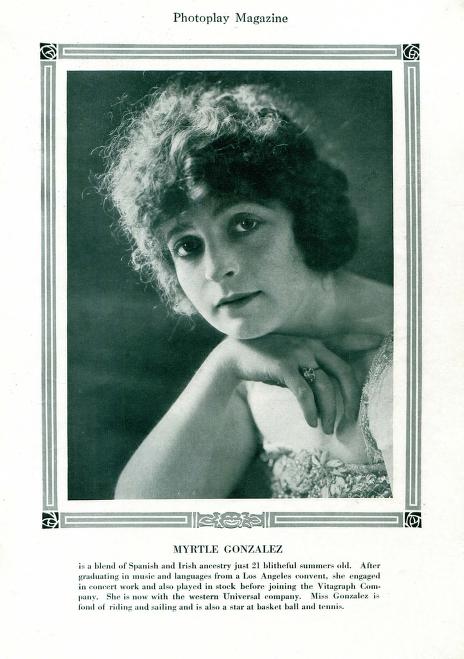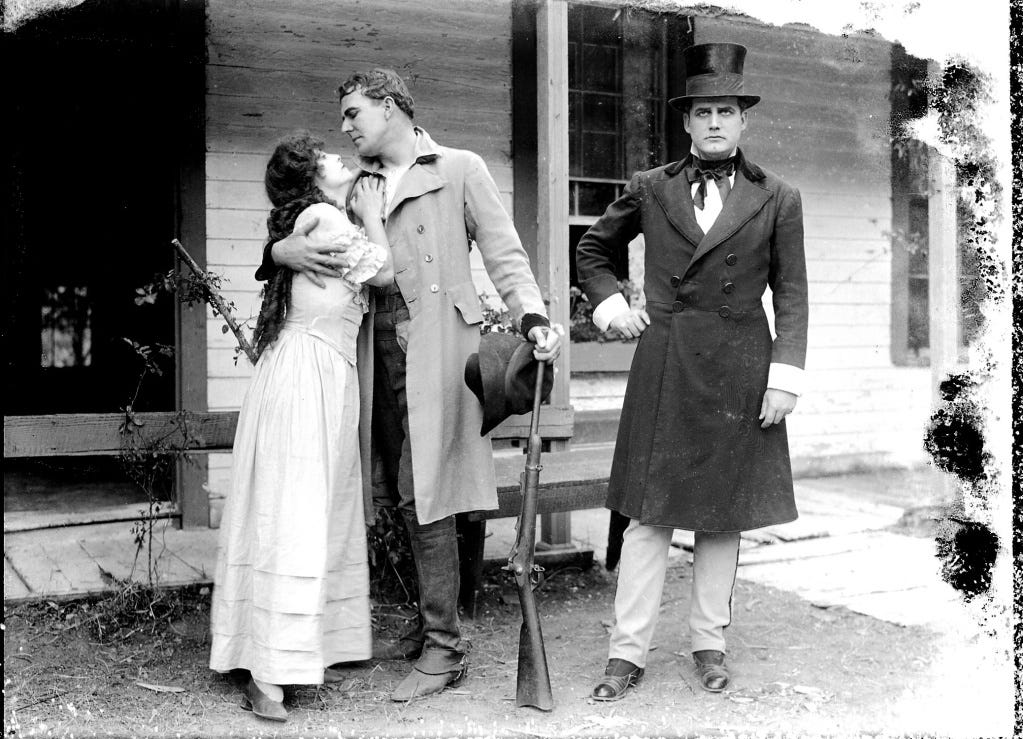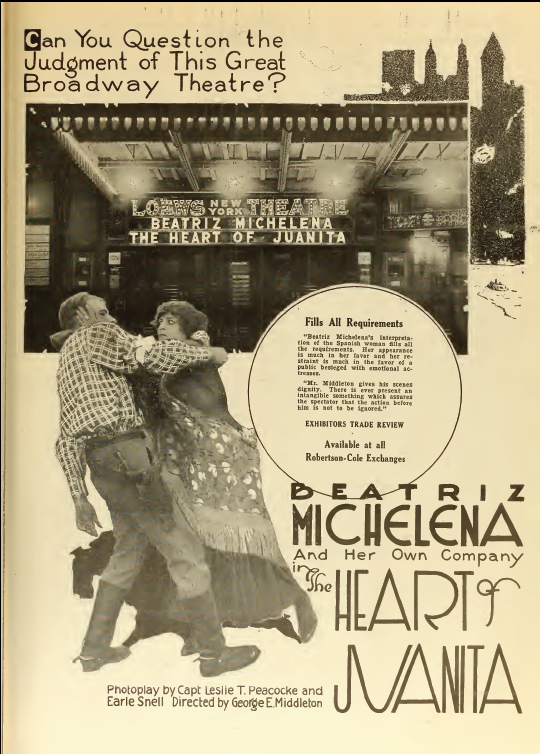Latin women in silent cinema: Myrtle Gonzalez and Beatriz Michelena
O mundo real é sexista. O mundo do cinema também.
Precisamos de Patricia Arquette clamando por salários iguais para homens e
mulheres em seu discurso do Oscar, precisamos de estrelas denunciando o sexismo
que existe dentro dos estúdios de cinema, precisamos de estudos que mostram que
a minoria dos roteiristas, diretores e produtores de filmes são mulheres. Mas
Hollywood nem sempre foi assim. Como toda novidade, a indústria do cinema, em
seus primeiros tempos, era vista com desdém, como mera curiosidade passageira,
e então muitas mulheres se envolviam no trabalho de fazer filmes. Na época do
cinema mudo, havia grandes roteiristas, diretoras, produtoras e, claro,
atrizes.
The real world is sexist. The movie world is sexist,
too. We need Patricia Arquette asking for equal payment for women and men in
her Oscar speech, we need film stars denouncing the sexism inside studios, we
need studies showing that the minority of screenwriters, directors and
producers are women. But it was not always like that. In its beginnings, the
film industry was seen with disdain and as a fad. The consequence: many women
were involved in making moving pictures. In the silent film era, there were many
great female screenwriters, directors, producers and, of course, actresses.
Se hoje ainda temos de lutar contra o estereótipo
da mulher-objeto, em especial quando a personagem feminina não é de origem
estado-unidense (hola, Sofía Vergara), esta questão era mais complicada
no passado. Nos anos 1910, personagens latinos se limitavam aos greasers: mexicanos
com longos bigodes e escuros sombreros que eram invariavelmente vilões
das películas. As mulheres latinas nestes filmes eram protótipos de femme
fatales, sedutoras e nem um pouco confiáveis. Mas, ao lado das maiores e
mais aclamadas atrizes da época, ao lado de Mary Pickford, Lillian Gish e Mabel
Normand, havia duas latinas que fugiam de qualquer estereótipo: Myrtle Gonzalez
e Beatriz Michelena.
If today we have to fight
against the objetification of women, in special when we are talking about
non-American women (hola, Sofía Vergara), this question was much more
complicated in the past. During the 1910s, the only Latin characters were the
greasers: Mexocan men with long moustaches
and dark sombreros who were always the villains in the movie. Latin
women were femme fatale prototypes: seductive and not trustworthy. But, next to
the biggest and most acclaimed actresses of the time, along Mary Pickford,
Lillian Gish and Mabel Normand, there were two Latin girls who didn't fit any
stereotype: Myrtle Gonzalez and Beatriz Michelena.
Myrtle
Gonzalez nasceu em Los Angeles em 1891.
A moça foi batizada com um nome 100% inglês, mas o sobrenome não deixa dúvidas
sobre sua origem: seu pai era de origem mexicana, e sua mãe de origem
irlandesa. Herdou da mãe o desejo de estar nos palcos, e começou a cantar e
atuar ainda criança. Em 1913, quando os estúdios de cinema começavam a mudar de
Nova York para Los Angeles, Myrtle conseguiu seu primeiro papel. Àquela altura,
ela estava divorciada e tinha um filho bebê. Abaixo está um GIF de seu terceiro
filme, “The Courage of the Commonplace” (1913):
Myrtle Gonzalez was born
in Los Angeles in 1891. The girl's first name was 100% English, but her last
name gives us no doubt about her origins: her father was from a Mexican family,
and her mother from an Irish one. She inherited from her mother the desire of
being on the stage, so she start singing and acting as a child. In 1913, when
film studios started moving from New York to Los Angeles, Myrtle got her first
role. At that time, she was divorced and had a baby son. Below there is a GIF
from her third film, “The Courage of the Commonplace” (1913):
Myrtle teve pequenos papéis em curtas-metragens
da Vitagraph, contracenando com William Desmond Taylor em cinco filmes entre
1913 e 1914. “The Kiss”, de 1914, é um dos poucos registros de Taylor em frente
às câmeras. A protagonista do filme é Margaret Gibson, que confessou, em seu
leito de morte em 1964, envolvimento com o misterioso assassinato de Taylor em
1922. Nada foi comprovado.
Myrtle had small roles in
Vitagraph shorts, playing alongsie William Desmond Taylor in five films between
1913 and 1914. “The Kiss”, from 1914, is one of the few extant registers of
Taylor in front of the cameras. The leading lady in this film is Margaret
Gibson, who confessed, in her deathbed in 1964, that she was involved with
Taylor's mysterious murder in 1922. Nothing
was ever proved.
No começo da carreira, Myrtle Gonzalez não teve
muito destaque, mas com o tempo conquistou papéis importantes. Suas
protagonistas, como em “The End of the Rainbow” (1916), eram heroínas corajosas
que viviam cercadas pela natureza e não se deixavam abater pelas adversidades.
In the beginning of her career, Myrtle didn’t call
much attention, but with time she got more important papers. Her leading
ladies, like in “The End of the Rainbow” (1916), were bold heroines who lived
among the nature and didn’t let bad times prevent her from succeeding.
A carreira de Myrtle foi breve. Em dezembro de
1917, ela deixou o cinema para se casar pela segunda vez. Menos de um ano
depois, em outubro de 1918, Myrtle Gonzalez sucumbiu à epidemia de gripe
espanhola. Tinha apenas 27 anos e um coração frágil. O viúvo Allen Watt dirigiu
e atuou em alguns poucos filmes da Universal nos anos 1920.
Myrtle's career was
brief. In December 1917, she left the movies to get married for the second
time. Less than a year later, in October 1918, Myrtle Gonzalez passed away from
Spanish flu. She was only 27 and had a heart condition. Her widower, Allen
Watt, direct and acted in a few Univwersal movies in the 1920s.
Beatriz
Michelena nasceu em nova York em 1890.
Seu pai era um tenor venezuelano que introduziu as duas filhas, Vera e Beatriz,
no mundo artístico. Vera ficou no teatro de Nova York, fazendo parte do elenco
do Ziegfeld Follies de 1914 a 1921. Beatriz se casou com um amor de infância em
1907, e se dedicou totalmente ao teatro nos anos seguintes.
Beatriz Michelena was born in New York in 1890. Her father was a
Venezuelan tenor and he introduced his two daughters, Vera and Beatriz, to show
business. Vera worked in the New York theater and was part of the Ziegfeld
Follies from 1914 to 1921. Beatriz married her childhood sweetheart in 1907 and
worked in theater the following years.
George E. Middleton, o marido de Beatriz, fundou
a California Motion Picture Corporation em 1912 para rodar filmes publicitários
dos automóveis que ele vendia. Em 1914, Michelena estreou nos cinemas com
“Salomy Jane”, um ambicioso e belo western com uma trama complexa e uma bela
atuação de sua protagonista. Teria nascido uma estrela para a California Motion
Picture Corporation?
George E. Middleton, Beatriz’s husband, created the
California Motion Picture Corporation in 1912 to make advertising films for the
cars he was selling. In 1914, Michelena made her debut in the movies with
“Salomy Jane”, an ambitious beautiful western with a complex plot and a great
performance by the leading lady. Was a star born for California Motion Picture
Corporation?
A produção caprichada deu uma ideia para George
Middleton: sua esposa poderia ser uma estrela maior que Mary Pickford! Beatriz
não chegou a este patamar, mas obteve relativo sucesso alternando westerns (em
que ela dispensava o trabalho de dublês) e adaptações de óperas.
The gorgeous production from 1914 gave an idea to
George Middleton: his wife could be a star bigger than Mary Pickford! Beatriz
didn’t reach this point, but she had some success alternating between westerns
(in which she dispensed stuntwomen) and opera adaptations.
Entre 1916 e 1917, problemas na produção do épico
“Fausto” levaram Beatriz a romper com a California Motion Picture Corporation.
Na época, ela escrevia uma coluna de jornal sobre cinema e dava dicas para
aspirantes a atrizes. Fragmentos de “Fausto” foram inseridos no filme “The
Price Woman Pays”, de 1919, mas Beatriz já trabalhava em outro empreendimento.
Between 1916 and 1917, problems involving the
production of the epic “Faust” amde Beatriz leave the California Motion Picture
Corporation. At the time, she also wrote a newspaper column about the movies
and gave tips to aspiring starlets. Stills from “Faust” were added to the film
“The Price Woman Pays”, from 1919, but Beatriz was already working with
something else.
No mesmo ano em que Mary Pickford se tornava
sócia da United Artists, Beatriz fundou sua própria produtora: Beatriz
Michelena Features. Foram realizados apenas dois filmes pela produtora, mas
eles foram suficientes para Beatriz marcar seu lugar na história.
In the same year that Mary Pickford became a partner
at United Artists, Beatriz created her own production company: Beatriz
Michelena Features. Only two films were produced there, but it was enough to
guarantee Beatriz a place in film history.
Aposentada das telas em 1920, Beatriz voltou à
ópera. Ela viajou pela América Latina cantando ópera em 1927, e em 1931 um
incêndio destruiu todas as cópias dos filmes da Beatriz Michelena Features
(algumas cópias sobreviveram em arquivos ao redor do mundo). Beatriz Michelena faleceu
em 1942, aos 52 anos.
Retired from the screen in 1920, Beatriz returned to
opera. She toured in Latin America singing opera in 1927, and in 1931 a fire
destroyed all the film copies at Beatriz Michelena Features (some copies
survived in archives around the world). Beatriz Michelena passed away in 1942, aged 52.
Myrtle e Beatriz, apesar de terem nascido nos
Estados Unidos, tinham a força e a graça do sangue latino. Não se curvaram
frente às adversidades, conquistaram um lugar ao sol, interpretaram mulheres
fortes e corajosas e deixaram um legado a ser admirado por todos, mulheres e
homens, latinos e não-latinos.
Myrtle and Beatriz, although American women by birth,
had the strengtth and grace found only in Latin blood. They didn’t give up when
obstacles appeared, they found a place in the sun, they played courageous
strong women and left a legacy that deserves to be admired by all, men and
women, Latin or not.
This
is my contribution to the Hollywood's Hispanic Heritage Blogathon 2015, hosted by Aurora at Once Upon a Screen. Bravo!














9 comments:
adorei o post. o pior são pessoas criticando os discursos. vergonhoso. beijos, pedrita
Me encanta esto, Le! Two early film stars I know little about and am sure few others do as well. Fantastic and important shout out!! Thanks so much for taking part in the blogathon!
Aurora
Oh dear....my knowledge of silent films is woefully lacking. I had never even heard of Myrtle Gonzalez. This was a wonderful read and thank you for introducing her to me!
Awesome post, my friend. So many stories lost to history. thank you for bringing these 2 stars to our attention.
That was a very interesting post! I have to admit to being unfamiliar with both actresses. I am so glad you posted on them!
Thank you for the profiles on these two silent film Latina actresses, Lê! I have heard the names before but am not very familiar - it was good to learn more.
Great post Le. Love how this blogathon has shone a spotlight on so many who should be remembered. Look forward to watching some of their roles and continuing my education :)
Oh, my silent film knowledge is woefully lacking, thank you for highlighting two important early female actresses, this was a lovely post, I will look for both of them in the future!
-Summer
Very nice post. Bem feito! I had not heard of these two silent film actresses. Thanks for sharing!
Post a Comment